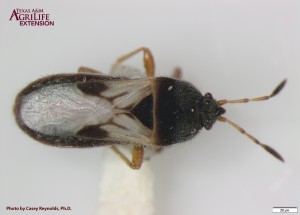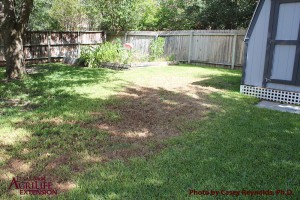Casey Reynolds, PhD, Mike Merchant, PhD and Diane Silcox Reynolds, PhD
Southern Chinch Bug: Blissus insularis
Description


Southern chinch bugs (Figure 1) belong to the insect order Hemiptera, suborder Heteroptera, and family Lygaeidae. They are common pests of St. Augustinegrass in the southern United States and often cause significant damage to turf during summer months (Figure 2). While St. Augustinegrass is the only turfgrass to suffer severe damage from chinch bugs, they have also been reported to feed on centipedegrass, zoysiagrass, bahiagrass and bermudagrass. However, feeding on these grass species is typically found only when they are grown in close proximity to St. Augustinegrass, and damage is minor.
Life Cycle

Southern chinch bugs go through gradual metamorphosis where they change from eggs, to nymphs, to adults. The adult southern chinch bug is 3 to 3.6 mm in length with a black body and white wings (Figure 3). Its wings are folded over the body and have a black triangle-shaped spot on each. During the winter months, adults are the most common life stage, but nymphs and eggs can also be present in small numbers.
Chinch bugs go through five life stages (instars) ranging in size from approximately 0.2 to 3 mm. Though small, they are still visible to the naked eye (Figure 4).

All chinch bug life stages can be found in the thatch and at the base of turfgrass plants. They damage grass by feeding on the phloem sap of the plant and injecting a toxin that results in death of plant tissue. If left un-treated, chinch bug damage results in irregular patches of yellowing turf that may spread outward and ultimately result in plant death. After nymphs have matured, adult chinch bugs disperse from affected areas primarily by walking, but also through mating flights. After mating, females lay their eggs into the crevices of grass nodes and at the junctions of grass blades and stems. Eggs take approximately 2 weeks to hatch depending on temperature, at which point the life cycle begins again.
Control Recommendations

One of the factors that makes southern chinch bugs particularly difficult to control is their rapid reproduction potential and short generation time. In Texas there may be up to 3 to 6 generations each year. Several insecticide active ingredients can effectively control chinch bugs, but application timing is a key component of success. Many of these product labels state that applications should be made prior to egg hatch, when 1st instar nymphs are observed, or when damage first appears. Therefore, it is important to scout for these pests prior to the onset of significant damage. This can be done by pulling back the turfgrass canopy and looking for the various nymphs and adults at the periphery of damaged and un-damaged areas (Figure 5). If chinch bugs are present, and unacceptable damage is occurring, insecticide applications should be made as soon as possible. Many of the products labeled for chinch bugs recommend watering the product into the turfgrass canopy to place it into contact with the chinch bugs, which maximizes control.
There are several active ingredients that are effective in controlling chinch bugs, but many variations exist in formulation, use site, applicator requirements, etc. As always, be sure to consult the product label for specific instructions on timing, use rate and application methods. For a complete list of products labeled for chinch bug control, consult the Texas Turfgrass Pest Control Recommendations Guide.